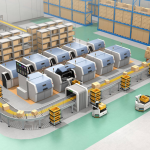A lot of changes have been made in the Fashion Culture with the help of technology. With the help of modern technology, the fashion culture is changing and growing rapidly. Although fashion and technology are two different things, technology has impacted the fashion culture a lot. Technology is now bringing about a commendable transformation to the fashion industry.
The Fashion industry, as among the world’s biggest businesses, is predicted to grow rapidly thanks to all technological improvements, with an expected value of around $3.3 trillion by 2030.
So, let’s learn in detail how technology and innovations are shaping the fashion industry today!

Fashion Culture and Technology: How Innovations Shaping the Industry?
The fashion industry is bringing a wide range of modern tools, methods, and technologies to change the traditional experience of shopping, for example, the Internet of Things (IoT), facial recognition, cashier-less stores, autonomous store assistants and delivery robots, AI, and voice commerce.
Fashion culture has upgraded so much that fashion products are now more accessible to customers and the procedure of purchasing one has become more convenient. So, let’s see how technology and innovations are impacting and changing the fashion culture and fashion industry around the world.
Internet of Things (IoT)

This is among the most rapidly developing and fascinating technological advancements in the fashion culture. It has a variety of benefits and applications in fashion retail and textiles, including a more acceptable understanding of client’s requirements and needs, optimizing product variety and personalized offers, improving the pattern, shape, and design, and having further insights to innovate, etc.
Over the past few years, wearable spaces, smart clothes, responsive athletics, and multi-functional designs have all increased significantly. As per a recent analysis, 70% of international retail and fashion decision-makers are planning to enhance customer experiences by simply implementing the IoT (Internet of Things).
Vector Editors Online
New Adobe editor alternatives are increasingly gaining popularity in the fashion culture. These are significant choices in case you are new to using the graphics design tool for designing. Or in case you do not have access to Sketch or Illustrator, all you have to do is simply use vector-graphics editing.
You will find online vector editors such as Boxy SVG Editor, Repsketch, and Vectr that can be used on any machine from anywhere.
Artificial Intelligence (AI) Technology
With the help of data compilation from social media and the Internet, the fashion culture has been capable of using Artificial Intelligence in many innovative ways, such as getting insights into quickly evolving fashion trends, knowing what shoppers want, helping in the design strategy, and collecting information on key elements of competing price points and fashion lines.
In this era of digitization, things have become more challenging for companies to know what their consumers want, thus, Artificial Intelligence is a helpful tool for doing the job. It allows brands to be better responsive to client preferences and feedback.
Another instance of a proper Artificial Intelligence application is the virtual stylists. They employ AI to assess information on body measurements, style trends, and consumer feedback to help human stylists in delivering a compact list of potential recommendations to clients.
The Arrival Of The Smartphones
The arrival of smartphones changed the industry as we all know it, as now people can shop, give feedback, and review things on the go from anywhere.
So, fashion retailers have started using virtual showrooms, virtual payments, and real-time consumer service to improve their business.
3-D Printing In the Fashion Industry
In several different ways, the use of 3D printing is allowing to innovate the fashion culture. The 3D printing items possibilities appear to be unlimited, ranging from women’s sportswear to accessories. It allows the innovation of personalized materials, which customers demand a lot.
The key advantage of using the 3D printing approach is that the designer can try again in case the design is not up to the mark. This technique has been in service since 2010, as well as the most complicated designs are easy to create using this technology.
Although this technique is still in progress and research is still going on, it’s expected to yield exceptional outcomes.
3D printing has not changed the fashion culture completely yet, however, we may be on the verge of a new revolution, something that is going to turn the whole fashion culture on its head.
In case the 3D printing process takes off as well as become economically bearable for customers, it will change the fashion industry a lot.
VR & AR (Virtual & Augmented Reality)
The use of virtual reality has completely changed the fashion industry. Without having to go to the store, customers may virtually try on several outfits on a screen. As a result, customers will get additional options and save time.
The virtual trial has grown in popularity over recent years. Customers can virtually try on clothing, footwear, and other goods using a 3D avatar.
Users using virtual makeover tools can alter or add a variety of features, such as virtual accessories, make-up, and haircuts, to the virtual style of people’s faces.
Quick Data Analysis For Rapid Adaptation
The fashion industry can swiftly modify its products (for example the supply chain) by leveraging vast amounts of data to enable this adaptation through the use of rapid data analysis.
Factories and brands can now obtain real-time notifications and feedback from businesses about damaged or defective products thanks to new software solutions that have now become accessible on the market.
This enables them to provide adequate items on schedule while also reducing costs and waste. They can even increase client pleasure by quickly determining potential threats to the company.
FINAL WORDS
The outlook for the fashion culture has changed primarily because of technical developments. The long-term viability of the fashion culture will be ensured by the right deployment of technology. The use of technology facilitates consumer purchasing.
Online shopping has become more popular, which has changed how fashion culture operates. Businesses cannot afford to overlook the newest technologies that will help them build their brands and win customers’ trust in the face of increased competition.















